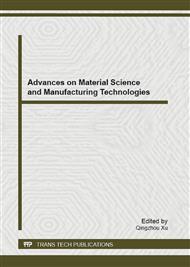[1]
S. Shrivastava, T. Bera, A. Roy, G. Singh, P. Ramachandrarao, D. Dash, Characterization of enhanced antibacterial effects of novel silver nanoparticles. Nanotechnology 18 (2007).
DOI: 10.1088/0957-4484/18/22/225103
Google Scholar
[2]
P. Li, J. Li, C.Z. Wu, Q.S. Wu, J. Li, Synergistic antibacterial effects of beta-lactam antibiotic combined with silver nanoparticles. Nanotechnology 16 (2005) 1912-(1917).
DOI: 10.1088/0957-4484/16/9/082
Google Scholar
[3]
S. Lee, J. Lee, K. Kim, S.J. Sim, M.B. Gu, J. Yi, J. Lee, Eco-toxicity of Commercial Silver Nanopowders to Bacterial and Yeast Strains. Biotechnol Bioproc E 14 (2009) 490-495.
DOI: 10.1007/s12257-008-0254-6
Google Scholar
[4]
S. Silver, Bacterial silver resistance: molecular biology and uses and misuses of silver compounds. Fems Microbiol Rev 27 (2003) 341-353.
DOI: 10.1016/s0168-6445(03)00047-0
Google Scholar
[5]
H.W. Liang, W.J. Zhang, Y.N. Ma, X. Cao, Q.F. Guan, W.P. Xu, S.H. Yu, Highly Active Carbonaceous Nanofibers: A Versatile Scaffold for Constructing Multifunctional Free-Standing Membranes. Acs Nano 5 (2011) 8148-8161.
DOI: 10.1021/nn202789f
Google Scholar
[6]
C.J. Murphy, T.K. San, A.M. Gole, C.J. Orendorff, J.X. Gao, L. Gou, S.E. Hunyadi, T. Li, Anisotropic metal nanoparticles: Synthesis, assembly, and optical applications. J Phys Chem B 109 (2005) 13857-13870.
DOI: 10.1021/jp0516846
Google Scholar
[7]
O. Akhavan, Graphene Nanomesh by ZnO Nanorod Photocatalysts. Acs Nano 4 (2010) 4174-4180.
DOI: 10.1021/nn1007429
Google Scholar
[8]
K.S. Novoselov, A.K. Geim, S.V. Morozov, D. Jiang, M.I. Katsnelson, I.V. Grigorieva, S.V. Dubonos, A.A. Firsov, Two-dimensional gas of massless Dirac fermions in graphene. Nature 438 (2005) 197-200.
DOI: 10.1038/nature04233
Google Scholar
[9]
C.G. Giske, D.L. Monnet, O. Cars, Y. Carmeli, R. -A.A. Resistance, Clinical and economic impact of common multidrug-resistant gram-negative bacilli. Antimicrob Agents Ch 52 (2008) 813-821.
DOI: 10.1128/aac.01169-07
Google Scholar
[10]
M.G.P. Page, J. Heim, Prospects for the next anti-Pseudomonas drug. Curr Opin Pharmacol 9 (2009) 558-565.
Google Scholar
[11]
P.A. Lambert, Mechanisms of antibiotic resistance in Pseudomonas aeruginosa. J Roy Soc Med 95 (2002) 22-26.
Google Scholar



